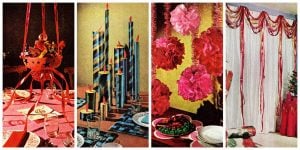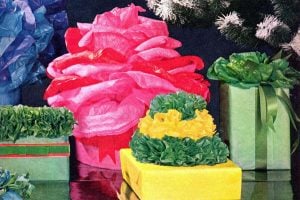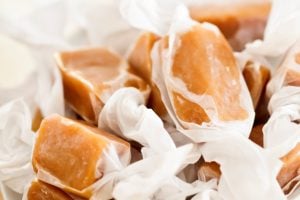Collectible ruby glass (1967)
American Home – November 1967
Anyone visiting Niagara Falls or a county fair in the 1890s was likely to bring home a piece of ruby-stained pattern glass as a souvenir.
Such novelties, turned out in hundreds of pressed patterns, were decorated in red stain baked on for permanence. They once sold for a song, and now are finds you’ll treasure.
Four famous patterns are in this collection (shown below): “Ruby Thumbprint,” one of the most popular, is on compote (top right), cream pitcher (bottom right) and berry bowl (below). “Prize” is on water pitcher (top left); “Crystal Wedding” on square pitcher (center); “Heart Band” on tumbler (far right).

The history of vintage ruby glass, and how to identify it (1961)
By Ann Kilborn Cole – The Philadelphia Inquirer (Philadelphia, Pennsylvania) July 16, 1961
Most of us are familiar with that brilliant ruby red glass, dark and rich… It is at its best a handsome glass, and at its worst not to be passed by, as its color makes it worth a place on the window shelf.
It is called Bohemian glass, and the question arises, is it really from Bohemia, the country that was once a part of Germany but is now included in the Czechoslovakian State? Yes, it was originally made in Bohemia, though the name is a generic one for that type of glass.
Bohemia for many years earned a reputation for its fine glassmaking, rivaling even Venice itself.
The glassmakers of Bohemia were German, and much of the decoration on the early pieces is quite ornate and German in character.
It was discovered in the latter half of the 17th Century when Bohemian glassmakers, in their effort to imitate Venetian glass, were left with a colorless potash-lime glass on their hands, which took to decoration, but had no claim to distinction in the way of color.
DON’T MISS: Early American portrait miniatures: See 38 tiny pieces of antique art history

Then someone (some say a man named Kunckel, others a Dr. Cassius of Hamburg) discovered that glass could be colored gorgeously red by adding an oxide of gold to the formula.
As it came out of the pot it was amber, but when articles made in it were reheated they became a clear and true red.
From that time on, although Bohemia made many other kinds of glass, when we speak of Bohemia glass today, we usually mean this particular type of red glass.
For a time this art seemed lost, but glass of a ruby color was made in Bohemia again at the beginning of the 19th Century, but instead of being colored in the mass, the pieces were made of a colorless glass and then encased with a thin layer of red.
ALSO SEE: Vintage Fostoria glass: 100+ old patterns, colors & styles of the classic American glassware
It is this glass, made around 1850, that we know the best today. Because of its two layers of glass, as it were, it gave great opportunity for dramatic cutting and engraving, the pattern showing op in the clear glass against the ruby ground.
At the New York’s Crystal Palace in 1853, this cased type of Bohemian glass was exhibited, and it became popular in this Country.
American glassmakers went to work to imitate it and called it “Bohemian” for the trade. It reached its peak in 1863.
By 1888, the old method of coloring ruby glass in the mass was revived in Bohemia, so that some imports date from that period.
And so today when you pick up a piece of this ruby red glass in a shop you are puzzled, and rightly so, whether it is truly German from the Old Country, or whether it began in one of our own glassmaking houses, such as the New England Glass Co. of Massachusetts.
One of the workers in that house, Lewis Vaupal, came to America in 1856 from Germany to work on their fine crystal, and brought styles of the best Bohemian wares of his time.
At the time of the Centennial Exhibition in 1876, he was chosen to work on some pieces of ruby glass for display there.
ALSO SEE: 60 vintage Libbey drinking glass designs from the ’60s

Now there is still another form of ruby glass with pretensions in the Bohemian manner. This is a flashed glass, meaning a clear glass treated with a layer of stain or paint.
Strictly speaking, this is not a true ruby glass, but it gets the effect of the older glass by showing its patterns in clear glass against the red flashing.
How are you going to tell these various types of so-called Bohemian glass? Naturally the finer the piece in other ways — the quality of the glass, the cutting, engraving, modeling, etc. — the more likely it is to have come from Bohemia.
If it is ruby clear through, it most certainly is the old product of that country, or a piece of the later revival in the late 1800s.
If it is cased, it could be either Bohemian or American — and if it is a truly fine piece, does it really matter?
If it is flashed you can usually tell because so often the flashing has begun to wear off.
While this ruby glass was used extensively for decorative pieces — vases, urns, bottles, bowls, etc. — it was also used for tableware such as goblets, wines, carafes, cordial sets, finger-bowls, fruit bowls, compotes and the like.
Many dresser pieces, such as perfume bottles and pomade jars, are found in it, as well as lamps and candlesticks.
Today, Czechoslovakia, the country that embraces the old Bohemia, is living up to its name in the making of tine glassware. Out of it is coming a great deal of this ruby glass. It is very good, and defies all but the experts to spot its modernity. Certainly, if you can’t get the old, the new is a very good substitute.
Sandwich ruby glass was most notable (1922)
From Antiques magazine – May 1922
Sandwich ruby glass was known not only in the American trade, but, it is said, attracted sufficient attention abroad to bring hither the representatives of European manufacturers, bent on learning the secret of its deep ruby color, which, in certain lights, took on an almost tawny metallic tint.

The secret lay in adding just the right amount of gold leaf to the mix in just the right way. But the precise definition of “right” Mr. Muldoon never divulged to anybody.
Ruby glass was occasionally combined with clear glass, as in the sugar tumbler shown [below]. The ruby of this, however, is hardly so fine as that of the celery tumbler shown beside it.

The latter, unfortunately somewhat damaged, displays a deep glowing red such as is seldom encountered.
Akin to ruby glass was a glass known as “amberina,” which was designed to give a reddish tone suffused with golden brown. It can hardly have been a great success, for the color tends to clouding, and seems to lack definitiveness of intention.



















